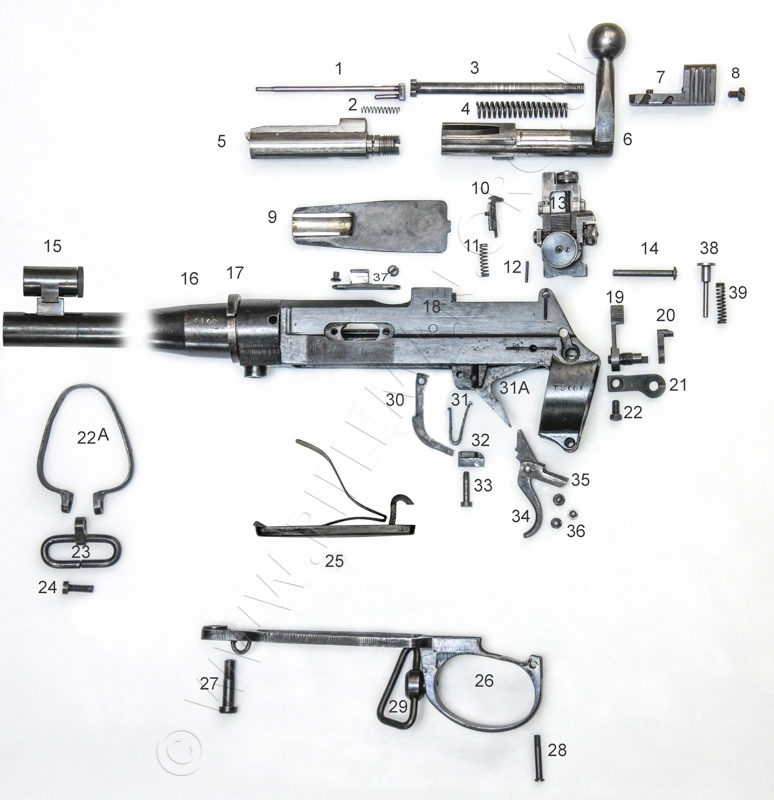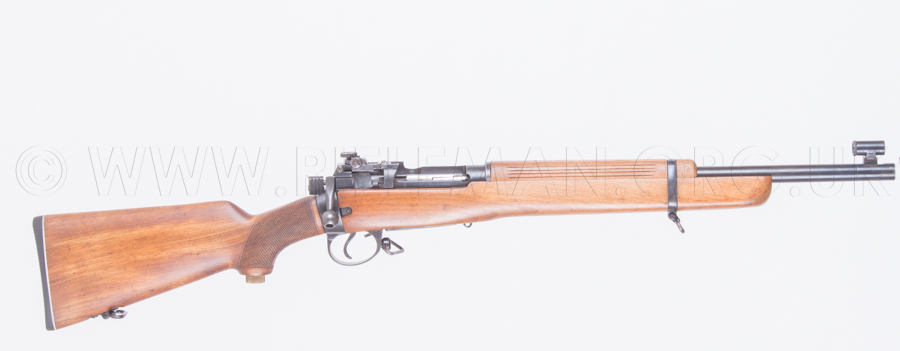See also: the main page for the various Lee-Enfield Rifles No.6
It being impractical to arrange 3D photography at museums such as the National Firearms collection, away from our base studio,
and wishing to illustrate such as the Lee-Enfield .22 No.6 trials/prototype training rifle in an all-round view,
we commissioned a close replication of that rifle utilising many original parts.
This allows sight of the furniture and other aspects not available on the static photos on the original rifle's main page,
as well as investigation of the progression of modifications through the sequence of these .22 Lee-Enfield rifles of the era.
This example differs most obviously in being the short rifle, rather than the long model,
the barrel being the same length (19") as that of the .22 No.5 rifle,
when the No.6 trials models were fitted with a barrel of greater length (22.5")
that was close to the 23.2" that would eventually be used in the following long-serving Rifle No.8.
The rear-sight fitted is as that on the No.5 trials rifle, and therefore
one of the three aspects here not representative of the original No.6 experimental model,
the last being the standard BSA tunnel fore-sight,
rather than the special version used only on the Nos. 5 and 6;
although it is mounted on a similar barrel sleeve to that of the trials rifles.
The next two images can be rotated and zoomed, either as initially loaded or full-screen for higher definition.
The provisonal nomenclature of Rifle, .22", No.6, was afforded these rifles
when produced experimentally by the Birmingham Small Arms Company in 1946.
Further information on this unusual situation can be found on the above linked page for that rifle.
The bolt of the .22RF No.6 rifle is unique, being of the same configuration as that of the preceding No.5 trials rifles,
but with the bolt-head lengthened by 11.5mm, and the body correspondingly shortened.
Instead of the 5-round magazine arrangement available with the .22RF No.5 rifle,
the No.6 has an integral sprung single-loading platform.
The No.5 model was also issued with a single-loading option, in the form of a second magazine insert
with a sprung "chute" follower in place of the repeating magazine follower.
With the No.6 trials rifle the complicated and expensive-to-produce magazine arrangement
was dispensed with, the magazine-well being blanked off at the base with a plate
dropped into the trigger guard aperture.
This blanking plate had a modified .303 magazine-follower spring riveted in place,
that spring bearing upwards upon the underside of the single-loading platform.
This platform was comprised of a flat plate with a ramped steel chute rivetted just aft of the rifle's breech,
which plate was depressed below the bolt-way by the underside of the bolt-head when a round was fed into the chamber.
Interestingly, this especially made bolt and head, of singular dimensions,
retained all the features necessary for magazine feeding.
It is a relatively simple matter to remove the trigger-guard unit's blanking plate
and the single-loading platform,
and fit a magazine capable of feeding .22 rimfire cartridges.
In fact, the blanking plate is only held into the trigger-guard magazine-way by virtue of
the spring pressure between its plate and the loading platform.
As can been seen looking at item 20 in the exploded view below,
the plate is prevented from dropping through the aperture by a flat lug at the front,
and by the curved lug at the rear engaging in the same detent on the magazine release lever
that would hold a magazine in place. The base-plate and spring can simply be dropped
out of the trigger-guard aperture by lifting the magazine release catch.
At that point, the single-loading platform could be removed, making way for the introduction of a magazine.
Indeed, on testing the proposition, the magazine from a .22 No.5 trials rifle does fit perfectly,
the attendant section and grooving in the bolt head being identical to that of the No.5,
albeit running 11.5mm further back, but this matters not.
The magazine from a R.A.F. Rifle No.7 also fits, although the magazine insert is set further back in the .303 shell.
The difference is about 7mm, and one has to wonder whether the longer bolt-head of the No.6,
that would be necessary to accommodate the difference in bolt travel,
was perhaps a foretelling of the configuration of the No.7 rifle.
On testing, the extra distance between the front of the magazine insert of the No.7 and No.5/6 rifles
made feeding unreliable, and the ejector would need to be modified slightly but,
otherwise, the utilisation of the cheaper to manufacture No.7 magazine
with its modified BSA Sportsman magazine insert would have been quite feasible with this longer bolt-head.
The rifle's furniture closely resembles that eventually used for the Rifle No.8,
in that the butt-stock was afforded a pistol grip, compared with the typical Lee-Enfield
issue butt-stocks used on previous trials and issue training rifles;
whilst the fore-end had a more triangular section, wider at the base for an improved hand-hold,
with the rifle evidently intended to present as a contemporary target shooting design,
rather than being a pure service rifle emulation. That being the case, the butt-plate
is a BSA moulded rubber one cast around a steel plate identical to those later
used on the No.8 rifle, rather than the standard brass Lee-Enfield butt-plate with trap.
The No.6 rifle was built on a No.4 Mk.1* type action that had been taken from the production line
prior to the machining of the rear of the receiver to accommodate the regular issue folding rear-sight leaf.
A one-off design of rear-sight was specially manufactured, with the lower windage component
fixed directly to the top of the rear of the receiver body,
of which the side plates had been machined flat for the purpose.
This could not be achieved with our rifle, which instead carries the earlier,
equally unique rear-sight leaf with integral windage adjustment, made for the .22 No.5 trials rifles.
The .22 No.6 experimental rifle, held in the National Firearms collection at the Leeds Royal Armouries,
is unusually fitted with a modified "king screw"angled sling-swivel of target and sniper rifle type -
- which would usually replace the trigger-guard front bedding screw - into the front of the actual trigger guard.
When in place, this would obviously preclude fitment of a magazine.
Whether this was a feature of all those few trials rifles produced we are unsure,
but its potential impracticality is probably evidenced by the contemporary addition of a traditional
2" wide canvas target-shooting sling to the NFC example, sadly attached by sling loops bolted to
those heavy wood screw-eyes commonly used at that time, and unsympathetically screwed into the fore-end wood.
Another one-off item on these rifles had to be the barrel-band, which needed to be enlarged
to encompass the wider fore-end wood. The fore-end of these trials No.6 models had the slightly widened
lower section, but when that was transposed to the No.8 trials and issue rifles it was widened yet further,
the No.6 stocking being of a configuration all of its own.
It is apparent that many of the features integrated into these trials No.6 rifles
found their way onto the No.8 trials rifles, and thence onto the issue training rifles,
but the main improvements incorporated into the No.8 design
were in the trigger mechanism and bolt arrangement, which can be viewed via the above link.
The bolt of the No.8 rifle was shortened considerably,
with the barrel breech being brought much further back into the receiver,
thus considerably reducing the lock time between trigger pull and striker release.
The trigger arrangement, although much improved on the No.5 and No.6 models by being
hung from the bottom of the action body, rather than being subject to movement in the woodwork
as were the preceding types, was a completely new and fully adjustable mechanism,
thoroughly suited to the potential use of the rifles, beyond that of basic training weapons,
into the realms of competitive target rifles.
Details of these improvements are available via the above associated link
Below is a disassembled view of our No.6 style rifle's ironwork components.

Parts Index
1 - Firing pin
2 - Return spring, firing pin
3 - Striker
4 - Spring, striker
5 - Bolt-head, with extractor
6 - Bolt body and handle
7 - Cocking-piece
8 - Locking Screw, striker
9 - Platform, single-loading
10 - Bolt release catch
11 - Spring, bolt release catch
12 - Locking pin, rear-sight pivot pin
13 - Rear sight, folding, with windage adjustment
14 - Pivot Pin, rear sight
15 - Fore sight, tunnel type, with interchangeable elements
16 - Barrel reinforce
17 - Ring, barrel handguard
18 - Receiver
19 - Lever, safety catch
20 - Catch, safety
21 - Locating detent spring, safety catch
22 - Screw, safety detent spring
22A - Barrel band
23 - Sling swivel, front, barrel band
24 - Screw, sling swivel
25 - Blanking Plate with follower spring, magazine way
26 - Trigger guard
27 - Screw, bedding, front, trigger guard
28 - Screw, trigger-guard, rear fixing
29 - Sling swivel, rear
30 - Release lever, magazine (when applicable)
31 - Spring, sear
31A - Lever, sear
32 - Locking nut block, magazine release lever and bolt release catch spring
33 - Screw, pivot, magazine release lever
34 - Trigger, two stage
35 - Mounting block, trigger
36 - Screws (3), trigger mounting block
37 - Ejector block and fixing screws (2)
38 - Plunger, rear sight
39 - Spring, rear sight plunger
For those further interested in the sequence of these post-WWII trials and training rifles,
see the intervening Lee-Enfield Rifle No.7 in both its British (Royal Air Force) and Canadian forms.

